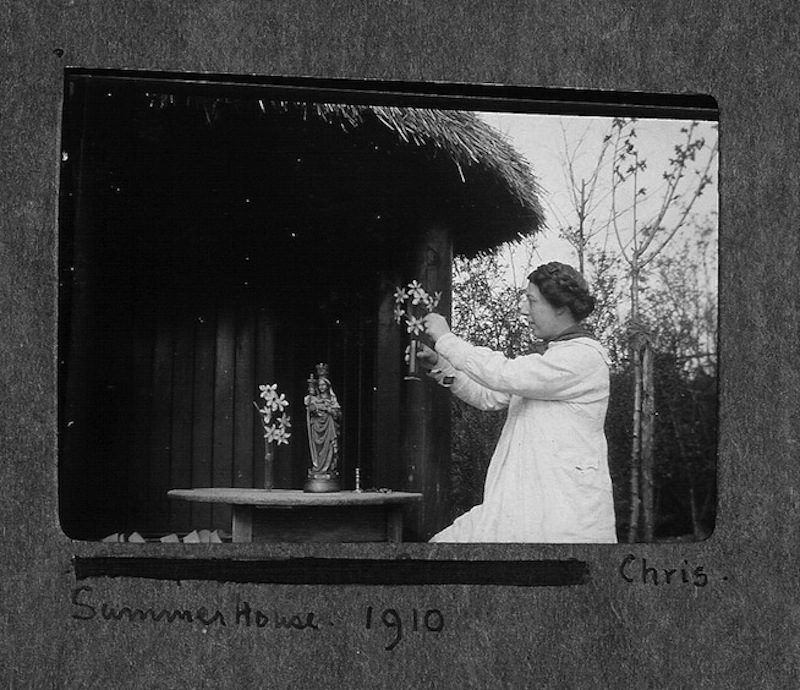David McAlmont shares a chance encounter with a lesbian icon, and discusses the mesmerising Girl Boy Child.
For the past two years David McAlmont has been working with the University of Leicester and the National Trust to bring lesser known queer histories out of the closets of some of the most beautiful historic houses in England and Wales.
Inspired by the extraordinary lives of three queer pioneers from the past, McAlmont has worked with Professor Richard Sandell and artist Julie Howell to create a mesmerising, immersive performance – Girl Boy Child – in the houses and archives that inspired him.
Here, he reflects on how lesbian icon, writer and suffragist, Christopher St John, came to take centre stage.
An autumn afternoon, 2017, the British Library, kind of frantic, but not because I have a deadline…
Yesterday I explored and handled an engaging, tactile item: a pale blue, boxed hardback called Hungerheart [sic]: The Story Of A Soul, begun by a female author in 1899. The only copy appears to be here at the library.
I am anxious to get back to it. I need it for research, but I am more captivated by the life unfolding within the pages. I’m amazed that it is not famous. I’m about to become its evangelist.
It is old, worn, worm-eaten, its pages disintegrating along the spine’s antique adhesive. A precious item in any collection, I am annoyed that I have been denied white gloves to handle it. Until, that is, I become electrified by its content.
Beginning in a dreamland where giant bluebells peal, it takes the reader on an awakening girl’s odyssey to womanhood; a confirmand besotted with crusaders; a prepubescent unfazed by her earnest desire to be emotionally involved with adult women; a youngest sibling who sits in conspiratorial conference with her brother’s discarded sailor doll; a sister who regards her sister’s frilly rag doll with contempt, accusing it of poisoning her sailor, sentencing the stuffed cloth to death; a gendered outcast despising boys who see cricket as male; a reluctant debutante who curses the absurd ritual of the “coming out” ball; a female Oxford student sickened by grudging male facilitation of women’s education; a suffragette firebrand who takes on mounted police at Whitehall with Japanese armour concealed beneath her clothing; an actress, an author, a proto-feminist lesbian.
I did not know that she was headed my way; I’m thrilled that she arrived. Her chosen name is Christopher St John. I mean her choice no disrespect, but I inadvertently take to calling her by her original name Christabel (Marshall).
Christabel will be central to the episodes of the project: an immersive, recited, sung odyssey through three queer lives lived in National Trust properties called Girl Boy Child.
“Boy” is William John Bankes, a Regency adventurer, who fled the death sentence in England after a second cottaging scandal. “Child” is Henry Cyril Paget, fifth Marquess of Anglesey, heir to England’s fourth largest fortune in 1898, burning through it within six years, frittering it away on Europe’s finest jewels and clothing, on pets, and touring his drama troupe across Europe. Christopher/Christabel becomes “Girl”. I borrow Hungerheart’s phase of life chapter titles, including Childhood and Juvenescence, as headings for the episodes of Girl Boy Child.
It is a chance encounter. After being roundly discouraged by a property once occupied by a reputedly lesbian couple in Cornwall, my colleague on the project, Professor Richard Sandell of the Research Centre for Museums and Galleries at the University of Leicester, suggests a visit to East Sussex, to experience some of the properties with rich queer histories in the area. First up, Sissinghurst, created by Vita-Sackville West and Harold Nicholson (both of whom had numerous same-sex affairs). It is beautiful but I don’t take to Vita; or perhaps it is Vita who doesn’t take to me.
We then visit Smallhythe, the Tudor manor over which the legend of Victorian actress, Helen Terry, and her costumier daughter, Edy Craig, presides. It was Helen’s home, Edy’s inheritance. Edy lived in a lesbian ménage a trois with Tony Atwood and Christabel on the property. Despite much talk of Edy and Helen, I am continually intrigued that afternoon by passing mentions of the passionate campaigner, writer and obsessive who stalked Edy’s mother, fell for her daughter, built herself a shrine and attempted suicide when Edy considered leaving her for man.
History it seems treats her as a supporting player, but in my heart, I determine to make her the star of my show.
